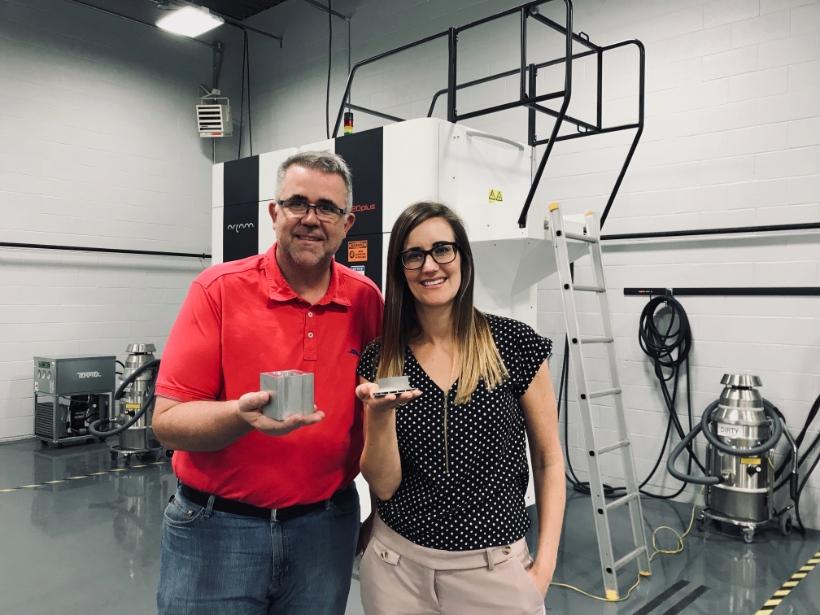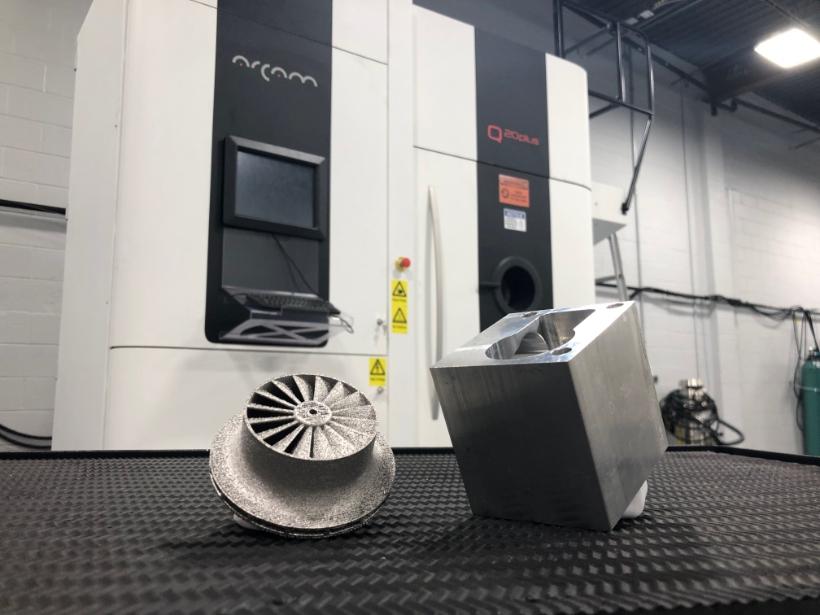- FMA
- The Fabricator
- FABTECH
- Canadian Metalworking
Our Publications
Categories
- Additive Manufacturing
- Aluminum Welding
- Arc Welding
- Assembly and Joining
- Automation and Robotics
- Bending and Forming
- Consumables
- Cutting and Weld Prep
- Electric Vehicles
- En Español
- Finishing
- Hydroforming
- Laser Cutting
- Laser Welding
- Machining
- Manufacturing Software
- Materials Handling
- Metals/Materials
- Oxyfuel Cutting
- Plasma Cutting
- Power Tools
- Punching and Other Holemaking
- Roll Forming
- Safety
- Sawing
- Shearing
- Shop Management
- Testing and Measuring
- Tube and Pipe Fabrication
- Tube and Pipe Production
- Waterjet Cutting
Industry Directory
Webcasts
Podcasts
FAB 40
Advertise
Subscribe
Account Login
Search
Transportation industry supplier opens additive manufacturing division
Trans Machine Technologies, a supplier of large parts to the rail, mining, and auto industry, launches AM division that operates EBM-type 3D printers to help it expand into aerospace and other sectors
- By Sue Roberts
- Updated June 14, 2019
- June 18, 2019
- Article
- Additive Manufacturing
Trans Machine Additive (TMA) is the new kid on the block at Trans Machine Technologies (TMT), an international supplier of large metal components for the railroad, mining, automotive, and OEM industries.
The new division’s goals are ambitious: provide creative additive manufacturing (AM) production options for its parent company’s existing customers, expand production in the U.S., and open new markets.
TMT, founded in 1997, uses traditional casting, precision machining, and fabricating technologies and has facilities in North Carolina, China, and Taiwan.
AM Seen as Next Step
A customer-centric approach to business, joined with a belief that AM is the next step in offering creative options for producing difficult components, led TMT’s CEO, Barry Leonard, to establish TMA in 2017.
Two Arcam EBM® (electron beam melting) machines are at the heart of TMA’s 22,000-square-foot facility in Winston-Salem, N.C. The build volumes of both machines, designed for production of aerospace components, allow for printing large parts. The Q20plus has a build volume of 350 millimeters [diameter] by 380 [height] mm. The A2X build envelope is 200 by 200 by 380 mm.
TMA President Laura Ely heads the expansion initiative. “The additive side of the company still has a transportation element because we are working with a lot of aerospace companies, but the additive capabilities are definitely opening up an array of other customer opportunities.
“EBM is considered an additive technology for lower-volume production runs and frequently makes sense as the process of choice for a single piece. It is being considered as a replacement process for gravity die casting,” she said.
Early Projects
Initially there was a steep learning curve for both TMA and its customers, and most proposed EBM projects were accepted.

Trans Machine Technologies CEO Barry Leonard holds a component machined conventionally. Trans Machine Additive President Laura Ely holds an additively manufactured component.
“We started out working on a wide variety of projects that often lacked clear technical definition,” Ely said. “It was a combination of customers not really understanding how to define an AM part or project and TMA not clearly understanding the process and how it fit with the application. That led to some confusion and mismatched expectations.”
As a result, the company revamped its technical sales and management process so it could do a better job of capturing customer requirements, performing risk assessments, and ensuring overall project success.
“Since the revamping, one thing we do more of is say ‘no’ to orders,” said Ely. “Just because AM can be used to build a part doesn’t mean it should be used. Truth in manufacturing is important to me personally. Yes, it is important to make money for the company, but we don’t want to misrepresent EBM capabilities. We could really set a customer back in their advanced technology journey by accepting a project that isn’t a good fit.”
If it’s not, she continued, “we will point them in a direction—AM or not—that might work for them,” said Ely.
She added that experimenting with parts and producing test samples increased the company’s understanding of the process itself, helped the company know what projects are well-suited for EBM, and made managing its own risks more effective.
High-Power Melting
During the Arcam EBM process, a high-power electron beam melts successive 70-micron-thick layers of metal powder, one on top of another, yielding a dense metal component. The process takes place in a vacuum at temperatures up to 1,100 C, resulting in stress-relieved components.
Material properties, according to the manufacturer, are better than cast and comparable to wrought materials.
TMA has found the EBM process to be a good fit with parts that require a high level of dimensional accuracy. An example is implantable devices that have relatively thin cases, which increases their chances of warping during the printing process.
“EBM builds them as a single part, the high heat provides stress relief during the process, and the parts have very good dimensional stability,” Ely said.

Additively manufactured part made by Trans Machine Additive (left) and conventionally machined part.
Shrouded and shroudless impellers, components for oil and gas applications, and parts for aerospace and defense applications comprise many of the other components produced using TMA’s EBM process. Material trials, including some nonstandard and nonspherical titanium characterization trials, for aerospace customers also are common.
TMA currently delivers titanium and nickel parts, although Ely said the company is interested in offering customers expanded material options. “Our conventional (Trans Machine Technologies) customers need parts that are more steel-based, so we are investigating if we can expand production to accommodate that need.”
Lessons Learned
Ely identified the following key lessons learned during TMA’s startup phase:
-- Design for additive manufacturing. It’s not enough to simply decide whether a part’s design makes it suitable for AM. It is imperative from a cost and time standpoint to design for AM and plan the entire manufacturing process before turning on the 3D printer. The printing portion of an operation often is less than 25 percent of the total production time and cost of making the part.
The final product requirements must be considered when choosing the right combination of traditional processes, said Ely. “There is all the postprocessing and inspection, and then the material that goes into the part. Those costs often get overlooked, which can be the make-or-break point for both technical and business project success.”
-- Establish good supply chain partners. “We are still learning how to best partner within the supply chain to ensure we have access to processes we do not have in-house,” said Ely. “And we are learning how to manage those partnerships to achieve on-time delivery and control costs.”
TMA seeks experienced suppliers and as many local suppliers as possible, she continued, “because the further you move parts, the more expensive it is and the bigger the chance for hiccups in delivery time.”
-- Get help. In the fall of last year, as part of a team revamp, TMA brought in technical experts on a contract basis. This allowed tapping into the expertise needed without taking on the burden of full-time staff.
On-Call Support
TMA partnered with The Barnes Group Advisors, an AM engineering, consulting, and training company, that provided strategic business leadership and engineering technical support.
This pairing gave TMA access to in-depth AM expertise on an as-needed basis, until the company’s growth warranted hiring full-time staff.
“This gives us a highly flexible company model that we call our Technical Excellence Resource Model,” Ely said. “During this early growth phase when our small business couldn’t maintain that caliber of full-time staff, we had access to a broad level of very specific, multidisciplinary AM expertise.”
TMA engineers currently run the company’s machines in addition to meeting customers’ technical requirements throughout the manufacturing process. As the company scales up, it expects to hire trained technicians to run the machines full-time and shift the engineers’ focus to design and problem-solving activities. Technical capabilities continue to increase as TMA works through ASTM standards, pursues other certifications, such as Nadcap (National Aerospace and Defense Contractors Accreditation Program), and satisfies customer-specific requirements.
“We are aligning our next steps where investment is required and going on the journey with different customers to qualify as a preferred supplier,” stated Ely. “We absolutely will build a bridge as far as fulfilling each company’s qualifications. It is worth working very carefully with our customers so they understand that as we put those qualifications in place, we are building a bridge to future work for them and earned revenue for us.”
About the Author

About the Publication
- Podcasting
- Podcast:
- The Fabricator Podcast
- Published:
- 04/16/2024
- Running Time:
- 63:29
In this episode of The Fabricator Podcast, Caleb Chamberlain, co-founder and CEO of OSH Cut, discusses his company’s...
- Trending Articles
- Industry Events
16th Annual Safety Conference
- April 30 - May 1, 2024
- Elgin,
Pipe and Tube Conference
- May 21 - 22, 2024
- Omaha, NE
World-Class Roll Forming Workshop
- June 5 - 6, 2024
- Louisville, KY
Advanced Laser Application Workshop
- June 25 - 27, 2024
- Novi, MI



























